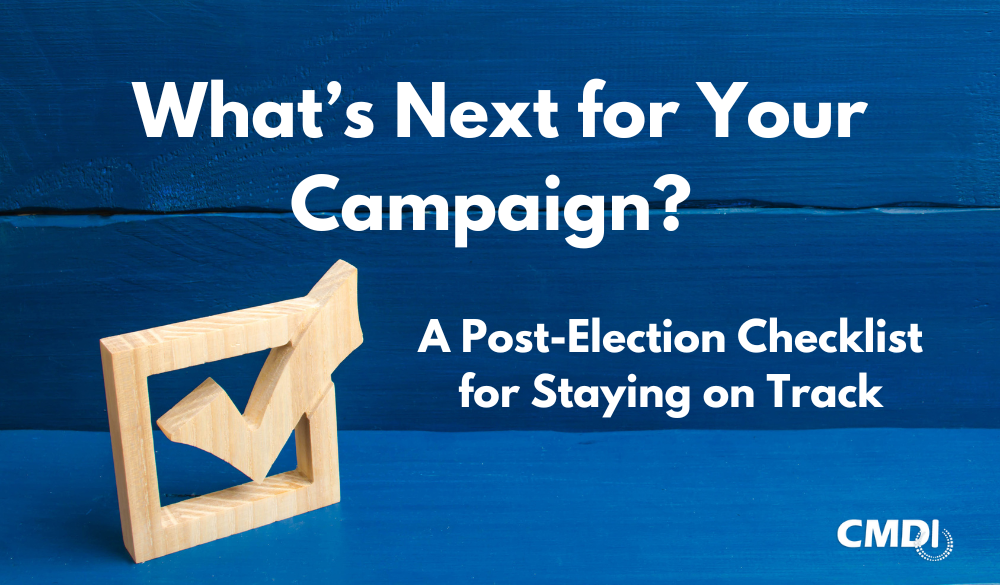What’s Next for Your Campaign? A Post-Election Checklist for Staying on Track
The election is over. While most of America is moving on and looking towards the return of the Trump administration, those who work in the political sector still have work to do for the 2024 cycle. Below is the CMDI checklist to help you stay on track.
1. Keep up with FEC Deadlines.
The 2024 cycle has two more deadlines:
Post-general on Thursday, December 5, 2024.
Year-end Report due on Friday, January 31, 2025.
Download CMDI’s one-pager of FEC deadlines for helpful reminders.
2. Update donation pages and disclaimers after Election Day.
Online donations received after the election:
• If you win: change the disclaimer on all your fundraising pages to say that any donations submitted after Election Day will go towards the next election.
• If you lose with debt: Change your disclaimer to say that donations received after Election Day will go towards debt retirement.
• If you lose with no debt, the recommendation is to remove your donation page.
Checks received after the election:
• Keep the envelope! You need the postmark to prove that it was mailed on or before Election Day.
• If it is from a fundraiser, you need proof or an affidavit that an agent of the campaign had the donation in hand on or before Election Day.
3. Start Sending Thank Yous.
Thank your volunteers:
• While this isn’t the most important legal step, it is the most important step to ensure future success. Start by sending a thank you email to your volunteers. If you have the time or money, have a small celebration with pizza or coffee to thank them for their free work!
Thank your donors:
• Your donors are your financial investors. Thank them for their contributions.
• If you won, you need them the next time you are up for re-election.
• If you didn’t win, you might need them for a future run. It’s hard to thank people too much.
Thank recurring donors appropriately:
Pull a list of your recurring donors and check the aggregate totals. Make sure that these donors are getting the same recognition as the ones who wrote out one-time checks. Take the time to send hand-written notes or call them.
Send a wrap-up note to your list.
• If you won, let your list know how you plan to transition into office. At the federal level, you will have an interest in jobs and internships. Let people know transition website addresses & information.
• If you lost, let people know what your plans are. If they donated, volunteered, or simply signed up for your email list, they are curious. Thank them for their support and end on a positive note.
4. Schedule a wrap-up meeting with staff.
Plan a review.
• Regardless if you won or lost, it’s smart to schedule a postmortem with your staff. Go over what worked and what didn’t work. What mistakes were made and what successes you had. Where could you have improved?
Write a postmortem report.
• Make sure you write these down! The lessons learned from your campaign are invaluable insights for future candidates and your staffers if they continue in politics.
• Don’t be afraid to be honest and brutal. Postmortem reports can be painful, but they will help candidates and staffers alike in the future.
• Make these reports available to your local party and staff.
5. Keep up with admin tasks.
Time sheets & taxes
• Tell staff deadlines for submitting time sheets.
• Collect forwarding addresses. If they were full-time employees, you will have to mail them a W2 for 2022. If they were independent contractors, they will need 1099. Check with your state to see what forms are needed for tax purposes.
• Cancel campaign credit cards. Make sure you aren’t left with charges from staffers after the campaign ends.
Balance your books
• Campaigns can’t move forward after the election until the books are balanced.
6. Decide what happens to your campaign committee.
Plans for what to do with your campaign committee after Election Day depend on two factors: what the candidate plans to do and if you have debts or leftover funds. Please refer to the FEC's guide on Winding Down a Campaign for additional information.
If you have leftover funds:
a. Convert to a PAC.
The most common tool for candidate committees that have money leftover after an election is to convert it to a PAC. The FEC does not allow active principal campaign committees to convert to a multi-candidate PAC, so they can only do this as an alternative to terminating the campaign.
To convert to a multi-candidate committee, you must file a new Statement of Organization with the FEC, change the name, and start following PAC reporting requirements. The new PAC is still responsible for paying any debts and responding to RFAIs that occurred while it was an active campaign.
b. Remain an active campaign after the election.
The main downside to converting from an active campaign committee to a PAC is the candidate decides to run for office again, the PAC can only contribute $5,000 to the new candidate committee. The FEC has specific rules about how these dormant campaigns can spend money.
If your candidate has remaining funds and decides to remain an active campaign in case of a future race, be aware that you must continue to submit FEC reports and be very careful how funds are disbursed.
c. Shut down the campaign committee:
If the candidate won, he or she can use leftover funds to pay:
Moving expenses to Washington, D.C. and other transitional costs
Security at their home and cybersecurity for official and personal online accounts & devices
If a candidate won or lost, he or she can use leftover funds to cover these categories:
Pay staff
Make donations to charitable organizations
Purchase gifts of nominal value to people who are not members of the candidate’s family.
Make unlimited transfer to national, state, or local party committee
If a candidate wishes to shut down the committee entirely, follow the FEC’s guide on Terminating the Committee. A special Termination Report will need to be filed and additional information provided.
If you have debt:
• The FEC does not allow a campaign committee to wind down if they still have debt.
• Check the FEC’s guides on debt repayment for loans and outstanding bills. The FEC has rules on how to pay different types of debts and negotiating settlements.
• There are special rules for fundraising to retire debt.
• Remember that while your campaign carries debt, you will have to continue filing reports.
7. Decide how to handle campaign assets.
The FEC also has rules and guidelines for how to handle the sale of campaign assets and how to report the proceeds of those sales. There are two big types of assets:
1. Physical assets: What do you plan to do with the leftover office equipment and supplies? If you plan to run again in the future, it might make sense to hold on to them, but where will you store it? If you lost, it probably makes sense to have a fire sale on those supplies. How will you run the sale and track money?
2. Mailing lists: Mailing lists have a monetary value. Decide who owns this asset and how it will be used. Will it be sold or transferred? Will there be a list broker? Will it be given to the state or national party?

